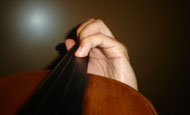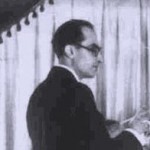Pattern No.3/1
Left hand finger Placement:
3/1/1: Landing Fingers on one String:
In preliminary stages of training, an apprentice should pay attention to the principle of keeping fingers while placing them on the fingerboard. Professional violinists pay less attention to this principle.
Novice player’s complying with this principle, in preliminary stages of training, has several advantages: firstly, gaining a more accurate understanding of how to land fingers on different positions in finger placement with different distances; secondly, increasing player’s physical ability in simultaneously keeping fingers on uncommon positions; thirdly, developing the ability to place one single finger on the fingerboard independent of other fingers.
Principle of keeping Fingers on a string:
When finger placement on a string starts from the first finger to the rest, besides keeping the last finger, the player should also keep previously landed fingers on the fingerboard. However, if finger placement is done out of order, there is no more need to simultaneously put previous fingers on the fingerboard.
For example if we have to play notes A to E subsequently on A string in first position, we should not raise its corresponding finger from the fingerboard after playing each note of this series. However, if we have to play note D immediately after playing free string, there is no need to put first and second fingers simultaneously with the third finger and the third finger can be put independently on the fingerboard.
It should be noted that performing this principle on a smaller scale is also the same. For example in subsequent playing of C, D and E on A string we should not pick the second and the third fingers up after performing C and D notes. In order to play note E immediately after B we should not put the second and the third fingers on the fingerboard. In this state the fourth finger lands on the fingerboard alone.
NB 14: Performing this principle in one position does not depend on the form of musical distances of fingers in the position in relation to each other.
3/1/2: Finger placement:
In order to reach accurate finger placement, it is better to consider the following points simultaneously:
3/1/2/1: When placed on violin fingerboard, fingers should be in a curved shape.
If a finger bends inward in its first joint, which makes a Λ shape, as it is called, instead of a curved shape, it will lead to pain in the finger in the long run. It also decreases player’s skill in finger placement.
3/1/2/2: Strings should always be touched (kept) through finger tips. Nails should not interfere in finger placement. When landed on the fingerboard, fingers should not be in a position in which player’s nail touches strings. In other words, player should not hold the strings with his nail.
In this false position, inward curved shape of fingers is decreased and an excessive pressure is beard by finger tip while finger placing. Also finger placement ability decreases leaving fingers with less independence in relation to each other while playing the instrument.
3/1/2/3: If we imagine that a line, in continuation of the finger length, divides this length into right and left halves, violin player should put left half of his finger tip on the fingerboard.
Because, firstly, considering the less distances between violin strings if a string is held by right half of the finger, the finger will approximately be placed on more bass string at the vicinity of the intended one.
Therefore, if there is a need to play a note with lower finger on a more bass string simultaneously (double-stop performance) or immediately after that, the player encounters a problem.
Secondly, finger placement using the right half of the finger tip will lead to the bending of the left wrist toward right which is not appropriate (See 2/1/3: Wrist).
3/1/2/4: Except when the performance of fifth Musical Interval (De la Quinte), is intended, the above-mentioned points regarding finger placement should be complied with in a manner so as to leave the neighboring high-toned string free.
NB 15: finger placement is done better when article 2/1/2, related to hand twist, is done in the best way possible.
*Therefore, the violinist should keep his nails as short as possible.
Correct style of placing the first finger in a curved shape:
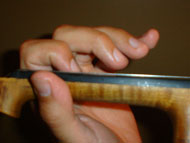
Correct style of placing the second finger in a curved shape:

False Way of First Finger Placement:
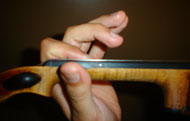
False Position of Nail on String
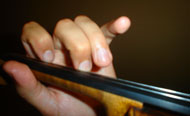
Accurate Style of Placing the Third Finger in Curved Shape:
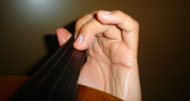
Accurate Way of Placing the Fourth Finger in a Curved Shape
